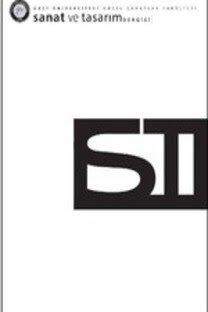Yemek Yeme Mekanlarının Oluşum Sürecinde Sosyo-Kültürel ve Fiziksel Belirleyiciler
Mekânsal üretim zengin bir oluumun maddelemi halidir. Mekân tasarımı esnasında;kültürün, sosyolojik ve psikolojik oluumların insan davranıları üzerinde etkisi iyianlaılmalı ve göz önünde tutulmalıdır. Kültürel girdinin oldukça youn olan yemekyeme mekânlarının fiziksel varlıklarını oluturan nesnel özelliklerin toplumsal ve kültürelkimlii zaman içerisinde farklı dönemlere aktardıını söyleyebiliriz. Bu kapsamda yemekyeme mekânlarının oluumunda fiziksel çevredeki stil, anlam ve normlara balı boyutlarile estetik beeninin kaynaı olan görsel öeler hakkında tercihler 'mekân-kültür' ilikisive 'baımlı, ara ve baımsız' deikenler betimsel analiz yöntemiyle farklı bir açısıgetirilmektedir
Anahtar Kelimeler:
-
-
Transferring a rich product of concrete communal formation, the physical spaces arecultural, sociological and psychological issues effecting human behaviour within theprocess of spatial design that should be understood and considered. With a quite widecultural input and comprehensive background dining spaces are the most commoninteractive social network depending on the meaning and dimensions of norms,preferences, and aesthetic appreciation of the visual elements, formation the physicalenvironment as the source of the judiciary and assessments. In this context, adescriptive analysing of the 'culture-space' relation and 'depended, intermediate and independed' variables are made
Keywords:
-,
___
- Agnew, Jeremy. “Representing Space (Space, Scale and Culture in Social Science)”, Place Culture Representation, (Edt.J.Duncan- D.Ley),London&New York: Routledge, 1993.
- Arslan, Mustafa , “Türk Popüler Dindarlıı”, Deerler Eitimi Merkezi Yayınları: stanbul, 2004.
- Boudan, Christian, “Mutfak Savaı – Damak Zevkinin Jeopolitii”, Ayrıntı Yayınları, stanbul 2006.
- Beardsworth, Alan, Bryman, Alan, “Late Modernity and Qualification: The Case of the Themed Restaurant”, Sociological Review, 47(2), ss. 228-257, 1999.
- Bedük, Didem, “ehir çi Otel Restoranlarının Tasarım lkelerine Bir Yaklaım ve stanbul’daki 1998.
- Uygulamaların rdelenmesi”, stanbul,
- Belge, Murat, Tarih Boyunca Yemek Kültürü, letiim Yayınları, stanbul, 2001.
- Bell, P. A.; Greene, T. C.; Fisher, J. D., Baum, A. “Environmental psychology”. Fort Wort: Harcourt, 1996, (4th ed., 5th ed. 2001).
- Bhatia, Anubhuti, “Effects of Interior Environment on the Dining Experience and Design of Master Theses, Florida State University, 2003.
- Prototype Seafood Restaurant”,
- Bozdayı, Aye. Müge, “ç Mekân ve nsan”, Ajans Matbaacılık, Ankara, Kasım, 2004.
- Curaolu, Füsun, “Konut Dıında Yeme levli Mekânlarda ç Mekân ile Mobilya ve Donatının Deien Kültürel ve Sosyal Yapı Paralelinde Etkileimi”, Sanatta Yeterlik Tezi, Hacettepe Üniversitesi, Ankara, 2000.
- Finkelstein, Joanne, “Dining Out: A Sociology of Modern Manners”, Oxford: Polity 1989.
- Gür, engül, Oymen, “Mekân Örgütlenmesi”, Gür Yayıncılık, Trabzon, 1996.
- Gürsoy, Deniz, “Yemek ve Yemekçiliin Evrimi”, SOFRA Yemek Üretim ve Hizmet A. ., Kuru Matbaacılık San. ve Tic. Ltd. ti., stanbul, Kasım, 1995.
- Grefe, Cristiane, “Hamburger Çaı”, letiim Yayınları, stanbul, 1994.
- Heide, M., Gronhaug, K., “Atmosphere: Conceptual Issues and Implications for Hospitality Management, Scandinavian Journal of Hospitality and Tourism”, Volume 6, Issue 4, pp. 271-286, 2006.
- Kırım, Arman,”Yeni Dunyada Strateji ve Yonetim”, Sistem Yayıncılık, stanbul, 1999.
- Lawson, Fred, “Restaurants, Clubs and Bars - Planning, Design and Investment”, Architectural Pr.: London, 1987.
- Malinowski, B. (1992). “Bilimsel Bir Kültür Teorisi”, (S. Özkal, Çev.). stanbul: Kabalcı. (Orijinali 1944’te yayımlanmıtır), 1992.
- Mennel, Stephen, Murcott, Anne, Van Otterloo, Anneke, “The Sociology of Food: Eating, Diet and Culture”, Sage Publication: London, 1992.
- Miller, Stuart, Schlitt, Judith, K., “Interior Space-Design Concepts for Personal Needs”, Praeger: New York, 1985.
- Rapoport, Amos, “House Form and Culture”, Englewood Cliffs, N.J.: PrenticeHall,Inc.,1969.
- Rapoport, Amos, “The Meaning of The Built Environment”, Sage: Beverly Hills, 1990.
- Ryu, Kisang, Jawn, SooCheong, “The Effect of Environmental Perception on Behavioral Intentions Through Emotions: The Case of Upscale Restaurants”, Journal of Hospitallity & Research, Vol.31, No:1, pp. 56-71, 2007.
- Ryu, Kisang, “Dinescape, Emotions and Behavioral Intentions in Upscale Restaurants”, Phd Desertation, Kansas State University Manhattan, Kansas 2005.
- Quinn, Thomas, “Atmosphere in The Restaurant”, Michigan State University Extension Tourism Educational Materials, 2002.
- ISSN: 1308-2264
- Yayın Aralığı: Yılda 2 Sayı
- Başlangıç: 2015
- Yayıncı: Ankara Hacı Bayram Veli Üniversitesi
Sayıdaki Diğer Makaleler
Bağımsız Kazakistan'ın Betimleme Sanatındaki Sanatsal Özellikler ve Yeni Alanlar
Lawrence Weiner'in Grafik Dili
Sanatta Gelenek Kavramına Postmodern Bir Bakış
Türk Mitolojisine Ait Unsurların Çağdaş Türk Resim Sanatına Kaynaklık Etme Sorunu
Jeneriklerinin Grafik Tasarımı Açısından Değerlendirilmesi
Yemek Yeme Mekanlarının Oluşum Sürecinde Sosyo-Kültürel ve Fiziksel Belirleyiciler
Görsel Sanatlarda Otobiyografik Anlatımlar
Form Bulma Kuramı ve Doğal Üzerinden Yapayın Keşfi Çalıştayı
